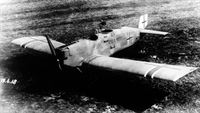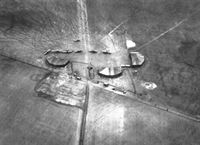
Описание
Страна: Германия
Год: 1918
Фронтовой самолет
Варианты
- Junkers - CL.I / J 8 / J 10 - 1918 - Германия
- Junkers - J 11 / CLS.I - 1918 - Германия
- В.Кондратьев Самолеты первой мировой войны
- А.Александров, Г.Петров Крылатые пленники России
- A.Kay Junkers Aircraft and Engines 1913-1945 (Putnam)
- O.Thetford, P.Gray German Aircraft of the First World War (Putnam)
- W.Green, G.Swanborough The Complete Book of Fighters
- J.Herris Development of German Warplanes in WWI (A Centennial Perspective on Great War Airplanes 1)
- M.Dusing German Aviation Industry in WWI. Volume 1 (A Centennial Perspective on Great War Airplanes 84)
-
В.Кондратьев - Самолеты первой мировой войны
"Юнкерс" CL-I, авиаэскадра немецкого добровольческого корпуса, зима 1918-19гг.
-
J.Herris - Development of German Warplanes in WWI /Centennial Perspective/ (1)
Junkers CL.I aircraft normally left the factory with green and mauve upper surfaces and light blue undersurfaces, with white rudder. The white fuselage band was a unit marking.
-
R.Bennett - Last Gathering of Eagles 1918-1920 /Aeronaut/
Junkers CL.I 12921 /18 "V", Staffel Majewski, Kampfgeschwader Sachsenberg (4. Plastun Aviation Division), Peterfeld, Autumn 1919.
-
R.Bennett - Last Gathering of Eagles 1918-1920 /Aeronaut/
Junkers CL.I "M", Ltn. Bruno Majewski? FA 417, Kampfgeschwader Sachsenberg, Wainoden, March 1919.
-
Jane's All The World Aircraft 1919 /Jane's/
The All-Metal Wireless Junkers CL.I ground attack and escort monoplane of 1918. (Junkers J 8)
-
W.Green, G.Swanborough - The Complete Book of Fighters
Image showing the prototype Junkers J.8 two seat close-support fighter. Work on the sole J.8 started in October 1917, aimed at providing a successor to the armoured Junkers J I. As it transpired, the J.8, with its 160hp Mercedes D III, had a top level speed of 116mph and impressed those that flew it at the first of the 1918 fighter trials. Not only did the J.8 lead directly to the CL I production contract, but its development contributed greatly to solving many of the single seat J.7's ongoing problems. Too late to have any effect in the air war, the 41 Junkers CL Is completed stood up well, alongside their single seat Junkers D I when operated in the 1919 Baltic War. Powered by a 185hp Benz Bz IIIa, the CL I had a top level speed of 118mph and a ceiling of 17,000 feet. Armament on later machines comprised two 7.92 Spandaus for the pilot, along with the flexibly-mounted 7.92mm Parabellum in the rear.
-
A.Kay - Junkers Aircraft and Engines 1913-1945 /Putnam/
A Junkers J8 (CL) close-support aircraft with balanced ailerons. This photograph is dated 2 January 1918. (Cross & Cockade)
-
K.Delve - World War One in the Air /Crowood/
Прототип "Юнкерс" J 10
An aircraft of advanced appearance, the Junkers J8 prototype of January 1918 incorporated many new features - not least the all-metal construction. In due course it gave rise to the J10, which subsequently entered production as the CLI. -
J.Herris - Weird Wings of WWI /Centennial Perspective/ (70)
The Junkers CL.I was the two-seat fighter development of the single-seat D.I. Larger than the D.I, it was powered by a 170 hp Mercedes D.IIIa engine and was armed with two fixed, synchronized guns for the pilot and a flexible gun for the observer. Developed from the very similar J 8 prototype, the production aircraft, first ordered in March 1918, was known as the J 10 to the factory. The CL.I went into production in the second half of 1918 to supplement the existing Halberstadt and Hannover CL-types, and 44 had been delivered through March 1919. The CL.I, along with the Junkers D.I, was used by the Geschwader Sachsenberg during the postwar fighting against the Bolsheviks in the Baltic. Both the D.I and the CL.I were very robust aircraft that served successfully in severe climatic conditions. The CLS.I was a floatplane derivative of the CL.I.
-
A.Kay - Junkers Aircraft and Engines 1913-1945 /Putnam/
The Junkers J10 (CL1) was a modified version of the J8 close-support aircraft. It was armed with machine guns and had ailerons flush with the wing tips. This one is c/n 1802/18.
-
H.Cowin - Aviation Pioneers /Osprey/
Один из серийных "Юнкерсов" CL-I перед отправкой на фронт.
Junkers J 10 (CL I) (prototype) -
R.Bennett - Last Gathering of Eagles 1918-1920 /Aeronaut/
Junkers CL.I (Jfa) 12608/18 of FA 431, with Uffz. August Qoos in the pilot's seat. The CL.I's monoplane configuration tended to make it look small - unless humans were present to give it a sense of scale. (August Qoos album via Greg VanWyngarden)
-
R.Bennett - Last Gathering of Eagles 1918-1920 /Aeronaut/
Ju. CL.I (Jfa) 12609/18 of FA 431, being inspected by Hpt. Ernst Otto Eberstein (in cockpit) and his O.z.b.V., Ltn. Martin, standing on the wing. An LVG C.V or C.VI is in the background.
-
R.Bennett - Last Gathering of Eagles 1918-1920 /Aeronaut/
Airfield of FA 406/Artillerie-Fliegerstaffel 127 near Meseritz. Aircraft in this photo appear to include four LVG C.VI, two Fokker D.VII, one Junkers CL.I, and one small two-seater, perhaps a Halberstadt CL.IV. (Author's collection)
Другие самолёты на фотографии: Fokker D.VII / V11 / V18 / V22 / V24 - Германия - 1917Halberstadt CL.IV - Германия - 1918LVG C.VI - Германия - 1918
-
W.Green, G.Swanborough - The Complete Book of Fighters
The CL I served post-World War I in the Baltic with the Geschwader Sachsenberg.
-
R.Bennett - Last Gathering of Eagles 1918-1920 /Aeronaut/
Two Junkers CL.Is of the FliegerAbteilung A17, Kampfgeschwader Sachsenberg, over Kurland. Other copies of this photo bear the inscription "Marz 1919", dating it to a two or three week period after the Geschwader's arrival in Kurland.
-
R.Bennett - Last Gathering of Eagles 1918-1920 /Aeronaut/
Detail from another photo of the lead aircraft, apparently taken during the same flight. This enlarged, digitally enhanced image reveals the squat letter"M"on the white fuselage band.The letter's significance isn't known, but might indicate this plane was the personal mount of the Abteilungsfuhrer, Ltn. Bruno Majewski.
-
R.Bennett - Last Gathering of Eagles 1918-1920 /Aeronaut/
Propping a Ju.D.I at Wainoden. The airship docking rail made a useful wheel chock.
Kampfgeschwader Sachsenberg's first base was the airship station at Wainoden in Kurland. Equipped with the latest products of the German aviation industry and using Schlachtstaffel tactics, it provided valuable support for the ground forces. Here using the airship shed guidance rails as chocks is a Junkers D I all-metal cantilever single-seater, with an LVG C VI and two Junkers CL I two-seaters in the background.Другие самолёты на фотографии: Junkers D.I / J 9 / J 7 - Германия - 1918LVG C.VI - Германия - 1918
-
A.Kay - Junkers Aircraft and Engines 1913-1945 /Putnam/
This picture, dated 24 March 1919, shows a 'civilianised' version of the J10 with a covering for the rear (passenger) seat.
-
M.Dusing - German Aviation Industry in WWI. Volume 1 /Centennial Perspective/ (84)
Demilitarized Junkers J.10 with cabin configuration for civil air transport, here flying between Dessau and Weimar, where the National Assembly of the Weimar Republic met in 1919.
-
R.Bennett - Last Gathering of Eagles 1918-1920 /Aeronaut/
Last stop for the German air force - the scrap heap. (Greg VanWyngarden)
Другие самолёты на фотографии: DFW C.V - Германия - 1916
-
R.Bennett - Last Gathering of Eagles 1918-1920 /Aeronaut/
Ju. CL.I 12921/18 "V" on its nose at Peterfeld. After the Germans'departure, the machine was taken over by the Latvian airforce.
-
R.Bennett - Last Gathering of Eagles 1918-1920 /Aeronaut/
Vizeflugmeister Hermann Hackbusch poses with his handiwork - Junkers CL.112600/18, nose down in the snow. (AHT AL0752-015)
-
R.Bennett - Last Gathering of Eagles 1918-1920 /Aeronaut/
Hackbusch wasn't the only pilot to be embarrassed on the snow-covered airfield - the same day, Vzfw. Fritz Todheide bellied in his Ju. CL.I less than 100 meters away. (AHT AL0752-012)
-
R.Bennett - Last Gathering of Eagles 1918-1920 /Aeronaut/
Ju. CL.I "M" met its end at Peterfeld in June. As noted earlier, this might have been Majewski's personal aircraft, but details of the markings suggest it was not the same machine that flew out of Wainoden in the Spring.
-
R.Bennett - Last Gathering of Eagles 1918-1920 /Aeronaut/
Mud bests metal - FA 431 Junkers CL.I overturned on rough ground. (August Qoos album via Greg VanWyngarden)
-
R.Bennett - Last Gathering of Eagles 1918-1920 /Aeronaut/
The wreck of this FA 417 Ju. CL.I testifies to the intensity of the 22 May battle for Riga. Because of their all-metal construction, Junkers machines were expected to better resist combat damage and were preferred for the dirtiest low altitude work. However, they were not armored and probably fared little better than their wood and fabric counterparts. Records make no mention of deaths of any flyers serving with FA 417 or on loan to FA 433 that day, but it's difficult to believe anyone survived this crash. (SDTB)
-
W.Green, G.Swanborough - The Complete Book of Fighters
The CL I was the ultimate wartime development of the line of Junkers monoplanes.
-
В.Кондратьев - Самолеты первой мировой войны
"Юнкерс" CL-I
В.Кондратьев Самолеты первой мировой войны
Цельнометаллический свободнонесущий моноплан с гофрированной дюралевой обшивкой всех поверхностей.
Конструкция самолета чрезвычайно перспективна для своего времени. Каркас крыла - клепаная пространственная ферма из дюралевых труб. Фюзеляж - полумонокок, в котором роль продольных силовых элементов выполнял гофр.
Машина спроектирована на фирме Юнкерс Флюгцойгверк в начале 1918 года как развитие типа одноместного истребителя "Юнкерс" D-I. Он отличался увеличенными размерами и наличием задней кабины, оснащенной турелью с пулеметом. Кроме того, было несколько усилено шасси. Первый полет прототипа с фабричным обозначением J 10 состоялся 4 мая.
Конструкция и внешний вид самолета были настолько необычны, что для него не нашлось даже соответствующего военного обозначения. Поэтому J 10 получил наиболее близкий по классу индекс "CL", т. е. легкий двухместный вооруженный ... биплан. Его намеревались использовать в качестве штурмовика и легкого бомбардировщика.
Военные заказали 50 экземпляров, из которых до конца войны удалось сделать 47 (по другим данным - лишь 37). Некоторые из них применялись осенью 1918-го в двух штурмовых эскадрильях на западном фронте. Никаких данных об их боевой деятельности не сохранилось.
Больше известно об использовании этих машин германским добровольческим корпусом генерала фон дер Гольца в Прибалтике в 1919 году. Это соединение воевало на стороне белогвардейцев против Красной армии, Его поддерживал авиаотряд, состоящий главным образом из "Юнкерсов" D-I и CL-I, не успевших попасть на фронты Первой мировой.
Летчики и механики оценивали их как исключительно надежные, выносливые и неприхотливые машины со вполне приличными летными данными. По свидетельствам пилотов, ни один другой самолет не выдержал бы и трех недель в тех условиях, в которых нечувствительные к сырости, дождю и снегу "Юнкерсы", базируясь под открытым небом, безотказно служили более полугода.
В послевоенное время некоторые CL-I также использовались для почтовых перевозок.
Также был создан вариант J 11 на поплавковом шасси. После войны на основе CLI производился почтово-пассажирский самолет J 10. Задняя пассажирская кабина самолета этого варианта закрывалась застекленным колпаком.
ДВИГАТЕЛЬ
"Мерседес"D.IIIA, 180 л.с.
ВООРУЖЕНИЕ
2 синхронных "Шпандау", 1 турельный "Парабеллум", до 30 кг мелких бомб.
ЛЕТНО-ТЕХНИЧЕСКИЕ ХАРАКТЕРИСТИКИ
Размах, м 12,0
Длина, м 7,9
Площадь крыла, кв.м 23,4
Сухой вес, кг 710
Взлетный вес, кг 1274
Скорость максимальная, км/ч 161
Время набора высоты, м/мин 1000/3,9
Описание:

































